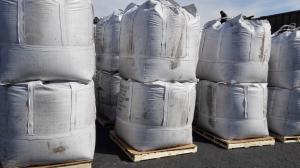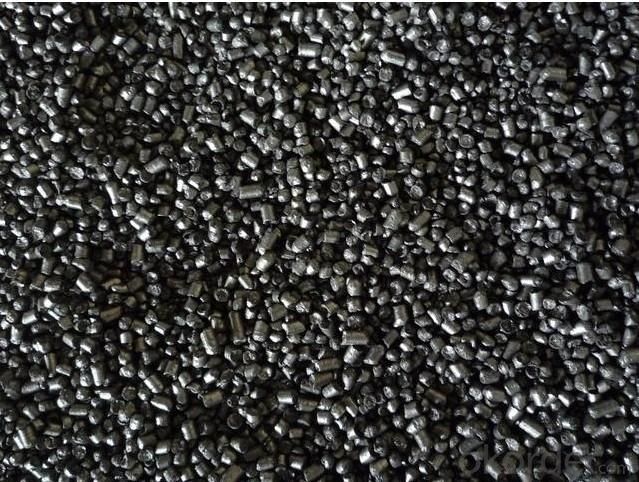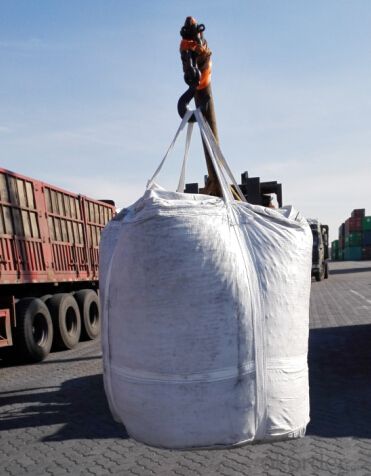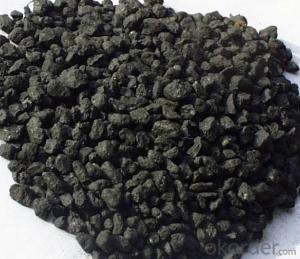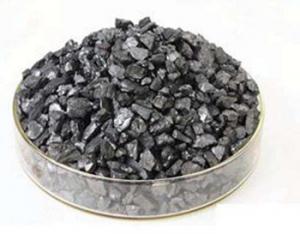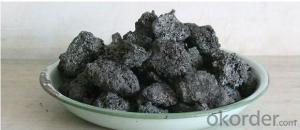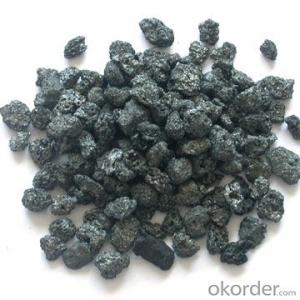Calcined Petroleum Coke FC98% S0.7% Cheap Price
- Loading Port:
- Tianjin
- Payment Terms:
- TT or LC
- Min Order Qty:
- 20 m.t.
- Supply Capability:
- 1500 m.t./month
OKorder Service Pledge
OKorder Financial Service
You Might Also Like
Packaging & Delivery
| Packaging Detail: | 50kg/bag 100kg/bag 1000kg/bag Or according with client need to do |
| Delivery Detail: | 2 weeks |
Specifications
Calcined Petroleum Coke FC98% S0.7% Cheap Price
Petroleum coke products can be divided into needle coke, sponge coke, projectile coke and coke breeze four kinds.
Calcined Petroleum Coke
F.C.: 98.5%MIN
ASH: 0.8% MAX
V.M.: 0.7%MAX
S:0.5%MAX
Moisture: 0.5%MAX
Structure
Calcined Petroleum Coke FC98% S0.7% Cheap Price
Shape: granule
Dimensions: 0-1mm, 1-5mm, 1-6mm, 2-8mm, etc
Product Type: Carbon Additive
C Content (%): 98-99.5% MIN
Working Temperature: -
S Content (%): 0.5%-0.7%MAX
Ash Content (%): 0.7%MAX
Volatile:0.8%MAX
Moisture: 0.5% MAX
ADVANTAGE: low ash & sulfur
COLOR: Black
Feature
Calcined Petroleum Coke FC98% S0.7% Cheap Price
Physics and chemistry performance :
Unit | Index | |||||
No.1 | No.2 | No.3 | ||||
Density | g/cm3 | 2.04 | 2.00 | 2.00 | ||
sulphur content | %≤ | 0.5 | 1.0 | 2.5 | ||
volatility | %≤ | 0.5 | 0.5 | 0.5 | ||
ash content | %≤ | 0.5 | 0.5 | 0.5 | ||
moisture | %≤ | 0.3 | 0.5 | 0.5 | ||
charcoal | %≤ | 98.5 | 98.0 | 98.0 | ||
Image
Calcined Petroleum Coke FC98% S0.7% Cheap Price

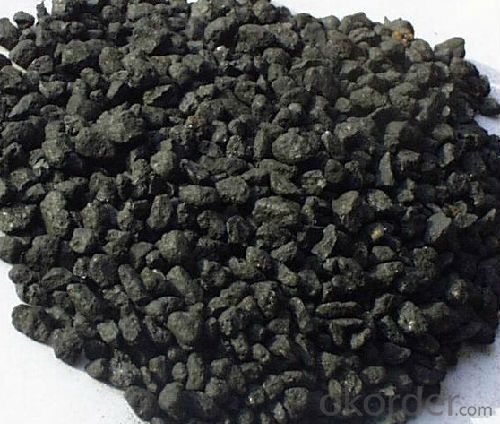
FAQ:
Calcined Petroleum Coke FC98% S0.7% Cheap Price
How to classify calcined petroleum coke?
1) According to difference of sulfur content, can be divided into high sulfur coke (sulfur content more than 4%), sulphur in coke sulfur content (2% 4%) and low sulfur coke (sulfur content below 2%).
2) Petroleum coke products can be divided into needle coke, sponge coke, projectile coke and coke breeze four kinds:
3) Needle coke, has obvious needle-like structure and fiber texture, mainly used for steel-making in high power and ultra-high power graphite electrode. As a result of needle coke in sulfur content, ash content, volatile matter and true density and so on have strict quality requirements, so the production process of needle coke and raw materials have special requirements.
4) The sponge coke, high chemical reactivity, low content of impurities, mainly used in the aluminum industry and carbon industry.
5) Focal or spherical coke: the projectile shape is round, diameter 0.6-30 mm, usually from the production of high sulphur, high asphaltic residual oil, can only be used as industrial fuel power generation, cement etc.
6) Coke breeze: fluidized coking process, the fine particles (0.1- 0.4 mm) in diameter, high volatile, high expansion coefficient, cannot be directly used for electrode preparation and carbon industry.
Advantage:
Calcined Petroleum Coke FC98% S0.7% Cheap Price
1. High quality and competitive price.
2. Timely delivery.
3. If any item you like. Please contact us.
Your sincere inquiries are typically answered within 24 hours.
- Q: What is the carbon emission of the air conditioner?
- Air conditioner using electric energy, itself is not the direct carbon emissions, but due to power consumption, power is not the primary energy, is two times the energy, so the power will come from where it is not decided or no pollution low and zero carbon emissions.Like water power, wind energy and solar energy, clean energy generates electricity without carbon emissions. It is pollution-free and zero carbon emissions. The use of coal raw materials power generation plants have carbon emissions, so air-conditioning carbon emissions is not easy to say, it depends on the specific circumstances analysis and decision.
- Q: How is carbon used in the manufacturing of electronics?
- Carbon is used in several ways in the manufacturing of electronics. One of the primary uses of carbon in electronics is as a key component in the production of carbon nanotubes. These nanotubes have exceptional electrical conductivity and mechanical strength, making them ideal for use in various electronic devices. For instance, carbon nanotubes can be used to create high-performance transistors, which are essential components in computer chips. Additionally, carbon is utilized in the manufacturing of batteries for electronic devices. Carbon-based materials, such as graphite, are commonly used as the anode material in lithium-ion batteries. This is because graphite can store and release lithium ions efficiently, allowing for the rechargeable nature of these batteries. Furthermore, carbon is employed in the production of conductive coatings and inks used for printed circuit boards (PCBs). Carbon-based materials, such as carbon black or carbon nanotubes, are added to these coatings and inks to enhance their electrical conductivity. This enables the proper flow of electrical signals throughout the circuitry of electronic devices. In summary, carbon plays a crucial role in the manufacturing of electronics. It is used in the production of carbon nanotubes for high-performance transistors, as anode material in lithium-ion batteries, and in conductive coatings and inks for printed circuit boards. These applications highlight the versatility and importance of carbon in the electronics industry.
- Q: How is carbon used in the production of solar cells?
- Carbon is not typically used in the production of solar cells as a primary material. However, carbon-based materials such as carbon nanotubes or graphene may be used as conductive additives or in electrode materials to enhance the efficiency and performance of solar cells.
- Q: How is carbon used in the production of rubber?
- Due to its unique properties and ability to enhance the overall quality and performance of rubber products, carbon finds widespread use in rubber production. An essential component in rubber manufacturing, carbon black is formed when hydrocarbons are incompletely burned. To enhance the strength, durability, and resistance to wear and tear of rubber, carbon black is added to rubber formulations. Acting as a reinforcing agent, it increases tensile strength and abrasion resistance by interlocking with the rubber polymer chains and fortifying the material's overall structure, making it more resilient. Moreover, carbon black improves the electrical conductivity of rubber, making it valuable in applications that require conductivity. It also enhances the rubber's resistance to degradation from exposure to sunlight by boosting its UV resistance. Furthermore, carbon black can enhance the color and appearance of rubber products, imparting a deep black hue. Furthermore, carbon black can serve as a filler in rubber compounds, reducing production costs while maintaining or even improving the rubber's mechanical properties. By substituting part of the more expensive rubber polymer with carbon black, manufacturers can achieve cost savings without compromising the desired performance characteristics of the rubber. In conclusion, carbon plays a vital role in rubber production by enhancing its strength, durability, conductivity, UV resistance, and appearance. Rubber products would lack the necessary properties for their intended applications without carbon.
- Q: What should be done to deal with leakage of carbon monoxide from the plant?
- The container should be cooled by heat in time. The harm to health, carbon monoxide and hemoglobin binding capacity than oxygen 200 times larger, after inhalation, in the blood and hemoglobin binding, interference blood carrying oxygen capacity, resulting in tissue hypoxia. The skin starts to become gray, and the skin and mucous membranes are red. Severe damage to brain cells can also cause secondary diseases, light damage to the heart, and damage to pyramidal or extrapyramidal systems, including the basal ganglia. Acute poisoning: mild poisoning are headache, dizziness, lethargy, tinnitus, palpitation, nausea, vomiting, weakness, abdominal pain, weakness and other symptoms; moderate poisoning in addition to the above symptoms, and complexion, lips cherry red, rapid pulse, irritability, instability of gait, fuzzy consciousness, coma patients remain unconscious;, miosis, muscle tension increased, frequent convulsions, incontinence, depth of poisoning due to respiratory paralysis and death. Chronic effects: the main manifestation of long-term inhalation of a certain amount of carbon monoxide, fatigue, irritability, indigestion and so on, can cause damage to the nervous and cardiovascular system. The compressed gas storage requirements in bottles, should be stored in a cool, ventilated warehouse, storage temperature should not exceed 300C; keep away from heat, avoid direct sunlight; and oxygen, compressed air, oxidant and stored separately; avoid mixed mixed transport. The lighting, ventilation and other facilities in the storage room shall be explosion-proof, and the switch is located outside the warehouse. Equipped with appropriate varieties and corresponding quantity of fire-fighting equipment.
- Q: What is latent carbon?
- With prochiral carbon atoms called prochiral molecules.For potential chiral compounds, can also be used to determine the order of rule configuration. For example, an atom of hydrogen by deuterium methylene propionate (D) replaced, if converted into R configuration, the hydrogen atom is called latent -R (pro-R) hydrogen atoms into S; if the configuration is called latent -S (pro-S the hydrogen atom).For medical workers, prochiral is an important concept. Almost all of the biological chemical reaction is controlled by the enzyme, the enzyme for prochiral molecules not symmetrically reaction, so they are able to identify two identical atoms or atomic groups, because they are chiral compounds. For example two methylene citric acid and only one methylene by enzymes (from rat liver) into carbonyl group.
- Q: What are the benefits of carbon-neutral technologies?
- Carbon-neutral technologies have numerous benefits, including the reduction of greenhouse gas emissions, mitigating climate change, and improving air quality. They also promote energy efficiency, stimulate innovation and job creation in the clean energy sector, and enhance energy security by reducing reliance on fossil fuels. Furthermore, carbon-neutral technologies contribute to sustainable development, foster international cooperation, and create a healthier and more sustainable future for all.
- Q: What's the difference between carbon steel pipes and stainless steel pipes and seamless steel tubes?
- Carbon steel pipe and stainless steel pipe with the material classification, and the seamless steel tube is shaped by divided categories.
- Q: How can Dungeon Fighter Online's superior furnace rock carbon be obtained?
- DNF advanced furnace carbon can acquire rock at the mall, priced at 450 points and 50 points 10 coupon coupon 1.The role is to use advanced furnace rock carbon can start at the Kylie advanced equipment reinforcement machine, strengthen the probability of success is greater!Point Keri election advanced strengthening, plus ten or more equipment to strengthen, the probability is 10% more than ordinary furnace carbon
- Q: What are the effects of carbon emissions on the stability of river systems?
- Carbon emissions have significant effects on the stability of river systems. The release of carbon dioxide and other greenhouse gases into the atmosphere contributes to global warming, which in turn affects the hydrological cycle and leads to changes in river systems. One of the primary effects of carbon emissions on river systems is increased water temperature. As the planet warms, the average temperature of water bodies, including rivers, rises. Higher water temperatures have detrimental impacts on aquatic ecosystems, leading to reduced oxygen levels and increased susceptibility to disease for many species. This can result in the decline or even extinction of certain fish and other aquatic organisms, disrupting the delicate balance of river ecosystems. Furthermore, carbon emissions contribute to the melting of glaciers and polar ice caps, leading to an increase in water volume in rivers. This can cause river systems to experience more frequent and severe flooding events. The excess water can erode riverbanks, leading to the loss of valuable land and infrastructure. It can also result in the displacement of communities living along riverbanks, exacerbating social and economic issues. Additionally, carbon emissions contribute to the acidification of water bodies, including rivers. Increased carbon dioxide in the atmosphere leads to higher levels of dissolved CO2 in rivers, forming carbonic acid when combined with water. Acidic water can harm aquatic life, particularly organisms with calcium carbonate shells or skeletons, such as mollusks and certain types of plankton. This can disrupt the food chain and have cascading effects on the entire river ecosystem. Overall, the effects of carbon emissions on the stability of river systems are profound. Increased water temperatures, flooding events, and acidification pose significant threats to the biodiversity and ecological balance of rivers. It is crucial to mitigate carbon emissions and adopt sustainable practices to preserve the stability and health of these vital ecosystems.
Send your message to us
Calcined Petroleum Coke FC98% S0.7% Cheap Price
- Loading Port:
- Tianjin
- Payment Terms:
- TT or LC
- Min Order Qty:
- 20 m.t.
- Supply Capability:
- 1500 m.t./month
OKorder Service Pledge
OKorder Financial Service
Similar products
Hot products
Hot Searches
Related keywords
